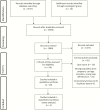Maternal Disease With Group B Streptococcus and Serotype Distribution Worldwide: Systematic Review and Meta-analyses
- PMID: 29117328
- PMCID: PMC5850000
- DOI: 10.1093/cid/cix660
Maternal Disease With Group B Streptococcus and Serotype Distribution Worldwide: Systematic Review and Meta-analyses
Abstract
Background: Infections such as group B Streptococcus (GBS) are an important cause of maternal sepsis, yet limited data on epidemiology exist. This article, the third of 11, estimates the incidence of maternal GBS disease worldwide.
Methods: We conducted systematic literature reviews (PubMed/Medline, Embase, Latin American and Caribbean Health Sciences Literature [LILACS], World Health Organization Library Information System [WHOLIS], and Scopus) and sought unpublished data on invasive GBS disease in women pregnant or within 42 days postpartum. We undertook meta-analyses to derive pooled estimates of the incidence of maternal GBS disease. We examined maternal and perinatal outcomes and GBS serotypes.
Results: Fifteen studies and 1 unpublished dataset were identified, all from United Nations-defined developed regions. From a single study with pregnancies as the denominator, the incidence of maternal GBS disease was 0.38 (95% confidence interval [CI], .28-.48) per 1000 pregnancies. From 3 studies reporting cases by the number of maternities (pregnancies resulting in live/still birth), the incidence was 0.23 (95% CI, .09-.37). Five studies reported serotypes, with Ia being the most common (31%). Most maternal GBS disease was detected at or after delivery.
Conclusions: Incidence data on maternal GBS disease in developing regions are lacking. In developed regions the incidence is low, as are the sequelae for the mother, but the risk to the fetus and newborn is substantial. The timing of GBS disease suggests that a maternal vaccine given in the late second or early third trimester of pregnancy would prevent most maternal cases.
Keywords: group B Streptococcus; incidence; postpartum; pregnancy; serotype.
© The Author 2017. Published by Oxford University Press for the Infectious Diseases Society of America.
Figures






References
-
- Say L, Chou D, Gemmill A et al. . Global causes of maternal death: a WHO systematic analysis. Lancet Glob Health 2014; 2:e323–33. - PubMed
-
- Loudon I. Maternal mortality in the past and its relevance to developing countries today. Am J Clin Nutr 2000; 72:241–6S. - PubMed
-
- Knight M, Kenyon S, Brocklehurst P, Neilson J, Shakespeare J, Kurinczuk JJ eds; MBRRACE-UK. Saving lives, improving mothers’ care—lessons learned to inform future maternity care from the UK and Ireland confidential enquiries into maternal deaths and morbidity 2009–12. Oxford: National Perinatal Epidemiology Unit, University of Oxford, 2014.
-
- Knight M, Nair M, Tuffnell D et al. . Saving lives, improving mothers’ care—surveillance of maternal deaths in the UK 2012–14 and lessons learned to inform maternity care from the UK and Ireland Confidential Enquiries into Maternal Deaths and Morbidity 2009–14. Oxford: National Perinatal Epidemiology Unit, University of Oxford, 2016.
Publication types
MeSH terms
Grants and funding
LinkOut - more resources
Full Text Sources
Other Literature Sources
Medical

